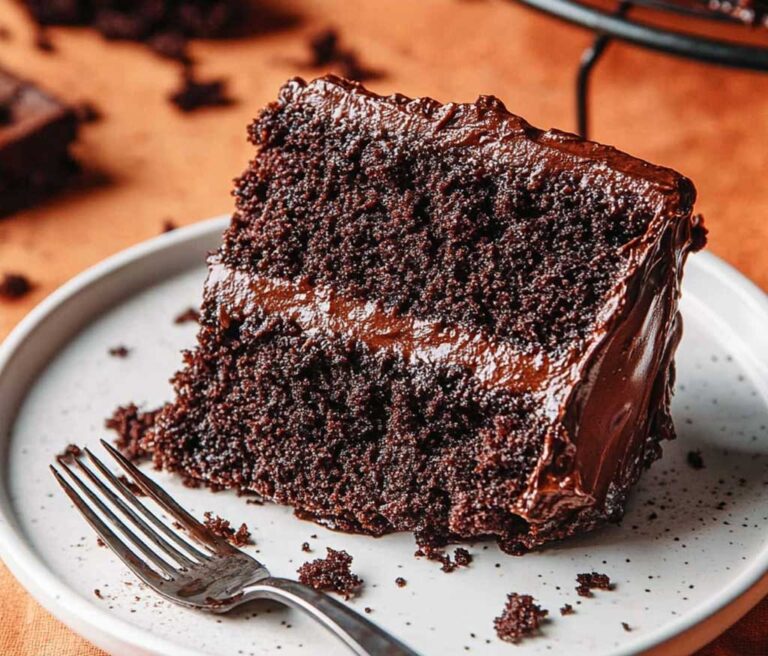Genoese Sponge Cake
Wow, I just had the fluffiest cake ever. It’s called Genoese Sponge Cake, and oh my gosh, it’s so good. Let me tell you all about it.
I love how each bite is, like, soft and sweet. It melts in my mouth, um, so quickly. It’s kind of magical.
Hey, I want you to crave it, too. The eggs and sugar create a yummy taste. We can whip it up in no time.
So, let’s go and make one together. Grab your mixing bowl now. Come on, let’s bake!

Why You’ll Love This Recipe
- Rich Yet Airy: The melted butter gives it a richer taste than a standard sponge cake while maintaining a delicate crumb.
- No Baking Powder or Soda Needed: This cake depends on air incorporated into the eggs for its structure—meaning technique is everything.
- Perfect for Layered Cakes: Holds up well to fillings and frostings without crumbling.
- Versatile Base: Can be flavored with citrus zest, coffee syrup, or even turned into a chocolate version.
- Authentic Bakery-Style Texture: Used in French patisseries for opera cakes and other elegant desserts.
What You Need to Know Before You Start
Genoese sponge requires precision, but once you master the technique, it’s a game-changer for home baking. Here’s what you need to know before starting:
1. The Role of Eggs
Since there’s no baking powder, eggs are the only leavening agent. Beating whole eggs with sugar until they triple in volume creates a stable structure that gives the cake its height.
Chef’s Tip: Use room-temperature eggs for better aeration.
2. The Importance of Gentle Folding
Adding flour too aggressively can deflate the eggs, resulting in a dense cake. Instead, use a spatula to fold it in gently, keeping as much air as possible.
Chef’s Tip: Sift the flour before adding it. This prevents clumping and makes folding easier.
3. Melted Butter for Tenderness
Unlike chiffon or angel food cakes, the Genoese sponge includes melted butter to add a slight richness. However, butter is heavy, so it must be folded in carefully to avoid deflating the batter.
Chef’s Tip: Mix a small portion of the batter with the butter first before adding it to the main mixture. This makes incorporation easier.
Prep & Cook Time
- Prep Time: 20 minutes (whipping eggs and preparing ingredients)
- Cook Time: 30 minutes
- Total Time: ~50 minutes
Note: This time does not include cooling and layering if you plan to add fillings.
Servings
- This recipe makes one 8-inch round cake, perfect for slicing into two or three layers.
- Can also be baked in a rectangular pan for making layered pastries like opera cake or a rolled sponge for Swiss rolls.
Difficulty Level
- Intermediate: The technique is simple but requires patience and precision when folding ingredients and whipping the eggs properly.

Required Kitchen Tools
Here’s what you’ll need for the best results:
✔ Mixing Bowls – Preferably metal or glass for whipping eggs effectively.
✔ Hand or Stand Mixer – Essential for whipping eggs to the right consistency.
✔ 8-inch Cake Pan – Greased and lined for even baking.
✔ Spatula – For gentle folding without deflating the batter.
✔ Saucepan – To warm the butter, which helps with smooth incorporation.
✔ Cooling Rack – Prevents condensation from making the cake soggy.
✔ Sifter – To aerate flour before folding it in.
Chef’s Tip: Use a springform pan for easy removal, as Genoese sponge is delicate.
Ingredients for the Genoese Sponge Cake
This recipe uses simple but essential ingredients. Measure everything before starting to keep the process smooth.
For the Sponge Cake:
- 4 large eggs (room temperature) – The key to a stable structure.
- ½ cup (100g) granulated sugar – Provides sweetness and stability when whipped with eggs.
- 1 teaspoon vanilla extract – Enhances the flavor.
- ¾ cup (95g) all-purpose flour – Sifted to prevent clumps and ensure a light texture.
- ¼ cup (30g) cornstarch – Makes the sponge more tender.
- 4 tablespoons (60g) unsalted butter – Melted and cooled, adding richness.
For the Filling (Optional):
- 1 cup heavy whipping cream – For a light, airy filling.
- 2 tablespoons powdered sugar – Sweetens and stabilizes the whipped cream.
- 1 teaspoon vanilla extract – For flavor.
- Fresh fruit (strawberries, blueberries, raspberries, or kiwi) – Adds freshness and color.
For Garnish (Optional):
- Powdered sugar – A classic finishing touch.
- Fresh mint leaves – For decoration.
Chef’s Tip: If making a layered cake, consider using a simple syrup (equal parts sugar and water, boiled) to brush over each layer for extra moisture.

How to Make Genoese Sponge Cake
Follow these steps carefully to achieve a light, airy, and perfectly structured sponge.
Step 1: Prepare Your Equipment
- Preheat the Oven: Set your oven to 350°F (175°C) and position the rack in the center.
- Prepare the Cake Pan: Grease an 8-inch round cake pan with butter or nonstick spray. Line the bottom with parchment paper to prevent sticking.
- Prepare a Bain-Marie (Double Boiler Setup): Fill a medium saucepan with 1 inch of water and bring it to a gentle simmer. This will be used to warm the eggs and sugar for better aeration.
Step 2: Whip the Eggs and Sugar
- In a heatproof mixing bowl, add 4 large eggs and ½ cup (100g) granulated sugar.
- Place the bowl over the simmering water (make sure the bottom of the bowl doesn’t touch the water).
- Whisk constantly for about 2–3 minutes until the sugar dissolves and the mixture is warm to the touch (110°F/43°C).
- You’ll know it’s ready when you rub a bit between your fingers and don’t feel any sugar granules.
- Remove from heat and immediately start whipping using a hand mixer or stand mixer on high speed.
- Whip for about 5–7 minutes until the mixture is pale, thick, and tripled in volume. The batter should fall in thick ribbons when lifted.
Chef’s Tip: Don’t rush this step! Properly whipped eggs create the cake’s structure.
Step 3: Fold in the Dry Ingredients
- Sift together:
- ¾ cup (95g) all-purpose flour
- ¼ cup (30g) cornstarch
- Add the flour mixture to the whipped eggs in three additions, sifting a little at a time.
- Use a spatula to gently fold it in with a circular motion from the bottom up.
- Avoid stirring or overmixing, as this will deflate the batter.
- Stop mixing as soon as you don’t see dry flour patches.
Chef’s Tip: If the batter deflates too much, the cake won’t rise properly.
Step 4: Incorporate the Melted Butter
- Melt 4 tablespoons (60g) unsalted butter and let it cool slightly.
- In a separate small bowl, mix a small scoop of batter with the melted butter.
- This helps lighten the butter so it mixes in smoothly.
- Gently fold the butter mixture back into the main batter until just combined.
Chef’s Tip: Butter is heavy, so adding it improperly can cause the cake to sink. That’s why we mix it with a small portion first.
Step 5: Bake the Cake
- Pour the batter into the prepared pan, smoothing the top with a spatula.
- Tap the pan lightly on the counter to remove any large air bubbles.
- Bake at 350°F (175°C) for 25–30 minutes, or until:
- The top is golden brown.
- A toothpick inserted in the center comes out clean.
- The cake springs back when lightly touched.
Chef’s Tip: Avoid opening the oven door too early, as this can cause the cake to collapse.
Step 6: Cooling the Cake Properly
- Remove the cake from the oven and let it cool in the pan for 5 minutes.
- Run a knife around the edges to loosen the cake.
- Flip the cake onto a wire rack, peel off the parchment paper, and let it cool completely before slicing.
Chef’s Tip: Genoese sponge is best when allowed to rest for a few hours before using. This makes slicing easier.

Serving and Decoration for Genoese Sponge Cake
The beauty of Genoese Sponge Cake is its versatility—it can be served as a simple cake with minimal toppings or transformed into an elegant dessert with layered fillings and frostings.
How to Serve Genoese Sponge Cake
Here are a few classic ways to enjoy this sponge cake:
1. Simple & Classic (Minimalist Approach)
- Dust with powdered sugar for a light, sweet touch.
- Serve with a dollop of whipped cream and fresh berries for a refreshing contrast.
- Enjoy with a cup of tea or coffee for a light afternoon treat.
2. Layered Cake (Perfect for Special Occasions)
- Slice the cake into two or three layers using a long serrated knife.
- Brush each layer with a simple syrup (made from equal parts sugar and water, boiled) to keep it moist.
- Fill with whipped cream, pastry cream, or fruit preserves.
- Frost the cake with buttercream, chantilly cream, or ganache.
3. European-Style Cakes (Elegant & Sophisticated)
- Use it as a base for Tiramisu by soaking layers in espresso and layering with mascarpone cream.
- Turn it into a Strawberry Shortcake by adding fresh strawberries and whipped cream.
- Use it as the base for an Opera Cake, layering it with coffee buttercream and chocolate ganache.
Decoration Ideas
For a Simple Look:
- Lightly dust with powdered sugar.
- Add a few fresh berries (strawberries, blueberries, raspberries).
- Garnish with mint leaves for a pop of color.
For a More Elegant Cake:
- Pipe whipped cream or buttercream rosettes around the edges.
- Drizzle with chocolate ganache for a luxurious finish.
- Decorate with edible flowers for a bakery-style presentation.
Chef’s Tip: If decorating with fresh fruit, glaze the fruit with a thin layer of apricot jam (warmed and strained) to give it a professional shine and keep it fresh longer.
Flavor Pairings
This sponge cake is neutral-flavored, making it ideal for a variety of fillings and frostings. Here are some delicious flavor combinations:
✔ Vanilla Genoese + Raspberry Jam + Chantilly Cream – Light and fruity.
✔ Chocolate Genoese + Coffee Buttercream + Dark Chocolate Ganache – Rich and indulgent.
✔ Lemon Genoese + Lemon Curd + Swiss Meringue Buttercream – Refreshing and tangy.
✔ Almond Genoese + Apricot Preserves + White Chocolate Ganache – Sophisticated and nutty.
Chef’s Tip: If making a layered cake, let it rest for at least 2 hours after filling to allow flavors to meld.
How to Store Genoese Sponge Cake
At Room Temperature (For Short-Term Storage)
- If undecorated, store at room temperature for up to 2 days.
- Wrap the cake tightly in plastic wrap to prevent it from drying out.
- Store in a cool, dry place away from direct sunlight.
- If the cake has fillings like whipped cream or pastry cream, do not store at room temperature—refrigerate instead.
In the Refrigerator (For Longer Storage)
- If stored in the fridge, the cake can last up to 5 days.
- Wrap it well in plastic wrap, then place it in an airtight container to prevent it from absorbing odors.
- If the cake is filled or frosted, keep it chilled and remove it from the fridge 30 minutes before serving to allow it to soften.
Chef’s Tip: Refrigeration can make sponge cakes feel dry. Brushing the layers with simple syrup before refrigeration helps retain moisture.
In the Freezer (For Long-Term Storage)
- Genoese sponge freezes well before frosting or filling.
- Wrap the cake tightly in two layers of plastic wrap, then a layer of foil to prevent freezer burn.
- Store in the freezer for up to 2 months.
- To thaw, transfer the cake to the fridge overnight, then let it sit at room temperature for an hour before decorating or serving.
Chef’s Tip: If freezing cake layers for later use, separate them with parchment paper to prevent sticking.
Make-Ahead Tips for Meal Prep
If you’re planning to use Genoese Sponge for an event or special occasion, here’s how to make it ahead for the best results:
1. Bake in Advance
- You can bake the sponge 1-2 days ahead and store it at room temperature, wrapped tightly.
- If making a layered cake, slice the cake only when ready to assemble to keep it from drying out.
2. Prep Fillings Ahead
- If using whipped cream, it’s best to prepare it fresh on the day of serving.
- Buttercream or pastry cream can be made 1-2 days ahead and stored in the fridge.
- Fruit fillings like strawberry compote or lemon curd can be made 3-4 days in advance and stored in an airtight container.
3. Assemble and Frost on the Day of Serving
- To maintain freshness, fill and frost the cake on the same day you plan to serve it.
- Let the assembled cake rest for at least 2 hours before slicing to allow flavors to meld.
Nutrition Information for Genoese Sponge Cake
Below is the approximate nutritional breakdown per one slice (assuming 10 slices per cake) without additional fillings or frostings.
| Nutrient | Per Serving (1 Slice) |
|---|---|
| Calories | 180 kcal |
| Carbohydrates | 25g |
| Protein | 4g |
| Fat | 7g |
| Saturated Fat | 4g |
| Cholesterol | 85mg |
| Sodium | 35mg |
| Fiber | 0.5g |
| Sugar | 14g |
| Calcium | 20mg |
| Iron | 0.6mg |
Note: This is a basic estimate and will vary based on exact ingredient brands, additional fillings, or decorations.
How to Make it Healthier
If you’re looking to modify this recipe for a healthier version, consider these adjustments:
✔ Reduce sugar: Cut the sugar to ⅓ cup (70g) to slightly lower calories and sweetness.
✔ Use whole wheat flour: Substitute ¼ of the all-purpose flour with whole wheat flour for more fiber.
✔ Replace butter with oil: Swap butter for an equal amount of neutral oil (such as avocado or olive oil) for a healthier fat profile.
✔ Use natural sweeteners: Instead of sugar, use honey or maple syrup, but adjust the flour slightly to balance the extra moisture.
Genoese Sponge Cake
Course: Cake Recipes20
minutes30
minutes180
kcalIngredients
- For the Sponge Cake:
4 large eggs (room temperature)
½ cup (100g) granulated sugar
1 teaspoon vanilla extract
¾ cup (95g) all-purpose flour (sifted)
¼ cup (30g) cornstarch
4 tablespoons (60g) unsalted butter (melted and cooled)
- Optional Fillings & Garnishes:
1 cup heavy whipping cream
2 tablespoons powdered sugar
1 teaspoon vanilla extract
Fresh fruit (strawberries, blueberries, raspberries, or kiwi)
Powdered sugar for dusting
Directions
- Prepare the Pan & Oven
Preheat oven to 350°F (175°C).
Grease an 8-inch round cake pan and line the bottom with parchment paper. - Whip the Eggs and Sugar
In a heatproof bowl, combine eggs and sugar.
Place the bowl over simmering water (double boiler) and whisk constantly for 2–3 minutes, until warm to the touch (110°F/43°C).
Remove from heat and whip with a hand or stand mixer on high speed for 5–7 minutes, until the mixture triples in volume and forms thick ribbons. - Fold in the Dry Ingredients
In a separate bowl, sift together flour and cornstarch.
Gently fold the flour mixture into the eggs in three additions, using a spatula. Avoid overmixing. - Incorporate the Butter
Melt the butter and let it cool slightly.
In a small bowl, mix 2 tablespoons of the batter with the melted butter to lighten it.
Gently fold the butter mixture back into the main batter until fully incorporated. - Bake the Cake
Pour the batter into the prepared pan, smoothing the top.
Bake for 25–30 minutes, or until the top is golden and a toothpick inserted comes out clean.
Let the cake cool in the pan for 5 minutes, then transfer to a wire rack to cool completely. - Serve & Decorate (Optional)
Dust with powdered sugar or slice into layers for filling.
Fill with whipped cream and fresh fruit, or use as a base for other layered desserts. - Storage Tips
Room Temperature: Wrap in plastic and store for up to 2 days.
Refrigerator: Store in an airtight container for up to 5 days.
Freezer: Wrap well and freeze for up to 2 months.
Genoese Sponge Cake FAQs
1. Why is my Genoese sponge cake dense instead of light and airy?
A dense cake is usually the result of under-whipping the eggs or over-mixing the batter. Ensure that the eggs are whipped until they reach the ribbon stage, and fold the flour in gently to avoid deflating the batter.
2. Can I make this cake without a hand mixer or stand mixer?
Yes, but it will require a lot of whisking by hand. You’ll need to whisk the eggs and sugar vigorously for about 10–15 minutes to achieve the correct aeration. Using an electric mixer is highly recommended.
3. My cake collapsed in the middle. What went wrong?
- Opening the oven door too early can cause the cake to collapse.
- Over-mixing after adding flour can knock out the air.
- The oven temperature may be too low—use an oven thermometer to check accuracy.
4. Can I make Genoese sponge cake in advance?
Yes! It actually improves in texture after resting for a few hours. Wrap it in plastic wrap and store it at room temperature for 1–2 days, or freeze it for up to 2 months.
5. What’s the best way to slice the cake into layers?
Use a long serrated knife and gently saw through the cake while rotating it. To make even layers, use toothpicks as a guide around the edges before cutting.
6. Can I make a chocolate version of Genoese sponge?
Yes! Replace ¼ cup (30g) of the flour with unsweetened cocoa powder and sift it well before folding into the batter.
7. What fillings go well with this sponge cake?
The cake pairs beautifully with whipped cream, fruit preserves, pastry cream, chocolate ganache, and buttercream. Light, airy fillings complement its delicate texture best.
8. Do I need to soak the cake with syrup?
If you plan to use this for layered cakes, brushing each layer with simple syrup (sugar dissolved in water) keeps it moist and enhances flavor. It’s optional but highly recommended.
Conclusion
Genoese Sponge Cake is a staple in classic baking, known for its light texture and delicate flavor. While it requires some technique, mastering it will elevate your baking skills and open up endless dessert possibilities.
Whether you serve it plain, layer it with fillings, or use it as a base for elaborate desserts, this sponge cake is versatile and delicious. By following the right techniques—proper egg whipping, gentle folding, and correct baking temperature—you’ll achieve a beautifully airy sponge every time.
Try different variations by adding citrus zest, cocoa, coffee syrup, or almond extract to create unique flavors. With this recipe, you’ll have a perfect foundation for classic European-style cakes and pastries.








